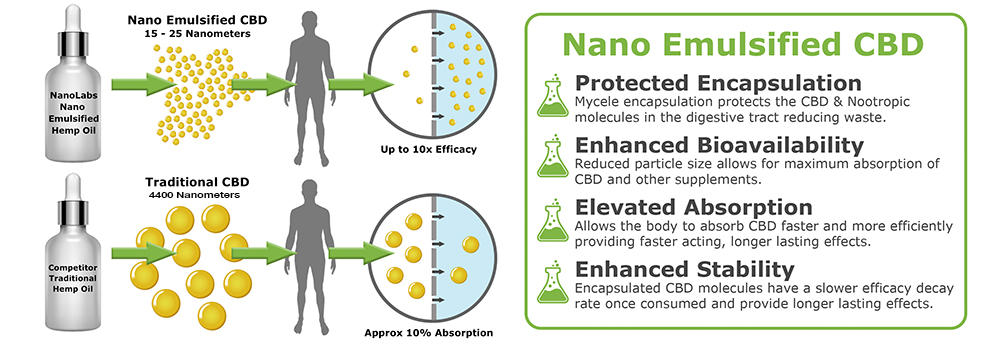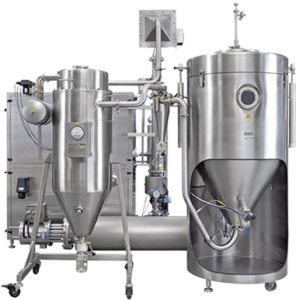
The Secret Sauce: Nano Emulsions
Nano emulsions are a type of emulsion, which is a mixture of two immiscible liquids (such as oil and water) stabilized by an emulsifying agent.
NanoLabs Tru-Nano Technology™ boasts not only water solubility, but an increase in efficacy and bioavailability of your high value active ingredients.

The goal of this process and benefits of our proprietary technology is to increase the bioavailability of the Active ingredient, making it easier for the body to absorb. This can lead to a number of potential benefits, including:
Faster onset of action: Because the smaller particle size of nano CBD increases its bioavailability, it may start working more quickly in the body.
Increased effectiveness: By making it easier for the body to absorb CBD, nano CBD may provide more consistent and potent effects compared to traditional, non-nano CBD products.
Improved stability: The process of creating nano CBD can also improve its stability, making it less likely to degrade or lose potency over time.
Enhanced solubility: Nano CBD is more soluble than traditional CBD, making it easier to incorporate into a wider range of products and formulations.
Cannabidiol (CBD) is a non-psychoactive compound found in the cannabis plant, and it has a long history of use for medicinal purposes. Here are some key milestones in the history of CBD:
Ancient times: Cannabis has been used for medicinal purposes for thousands of years in various cultures, including ancient China and India. The use of cannabis for treating a variety of medical conditions was documented in numerous medical texts and practices.
19th century: The discovery of the active compounds in cannabis, including CBD and tetrahydrocannabinol (THC), led to the study of the plant’s medicinal properties. CBD was first isolated in 1940 by Roger Adams, an American chemist.
Mid-20th century: The use of cannabis for medicinal purposes declined due to the rise of synthetic drugs and growing concerns about the plant’s psychoactive effects. The Marihuana Tax Act of 1937 effectively banned the use of cannabis in the United States.
1980s-1990s: The discovery of the endocannabinoid system in the human body, and the realization that CBD could interact with this system to produce therapeutic effects, renewed interest in the medicinal use of cannabis.
Late 20th and early 21st century: The growing scientific understanding of the medicinal properties of CBD, combined with changes in laws and regulations, has led to an increase in the use and availability of CBD-based products, including oils, tinctures, edibles, and topicals.
Today, CBD is widely recognized for its potential to help with a range of medical conditions. While the use of CBD is still the subject of ongoing research and debate, its popularity and availability have increased dramatically in recent years, and it is now widely used as a natural remedy and alternative to traditional pharmaceuticals.

Nano emulsions are a type of emulsion, which is a mixture of two immiscible liquids (such as oil and water) stabilized by an emulsifying agent.

The history of spray drying can be traced back to the late 19th century, when the process was first used to produce dried milk and

The history of nanotechnology can be traced back to the late 1950s and early 1960s, when scientists first began to explore the properties and behavior